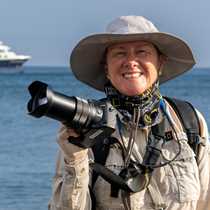Glacier Bay National Park
Our high pressure zone from last night, which brought clear skies and made visible the northern lights (at 11:00 p.m.), had been replaced by a low cloud cover by morning. However, it didn’t stop us from some fabulous sightings today inside Glacier Bay National Park. We cruised up to South Marble Island, where the sights, sounds, and even the smell of Steller’s sea lions carried easily over the water to all of us on the outside decks. Competing for sound space were the calls of glaucous-winged gulls (a new 2005 addition to South Marble residents), black-legged kittiwakes, the occasional raven, tufted puffins, marbled murrlets, and guillimots. As we passed Sandy Cove, an announcement came over the P.A. that a swimming moose had been spotted! Appearing out of no-where, heading towards the closest island, swam a female moose with ears pricked up, chugging along like the Energizer Bunny. She had the time and curiosity to turn her head our way in order to get a good look at this large object sliding by, without missing a stroke. When we left she had at least another hour’s swim ahead of her to reach shore, by our estimation.
Nannies with kids were seen perched precariously (to us) along the grim-looking sheer walls of Gloomy Knob, contentedly grazing or resting. I’m referring to the mountain goats, of course.
The most spectacular of our sightings was coming around Jaw Point into Johns Hopkins Inlet and finding the water virtually clear of ice bergs all the way to the face of this most imposing glacier. We sat a ¼ mile off the face for a long time, yet the glacier held her peace, dropping small nuggets (the size of small cars) into the water every so often, the sound arriving a second later to our ears.
We may not have seen the far vistas of the peaks of Glacier Bay National Park today, but with the help of our talented park ranger, Kevin Richards, we learned a tremendous amount of how the bay was formed over time and about what was now inhabiting the wilds. With words we learned to imagine the retreat of the glacier over a period of time of 200 years. We learned enough to know that there is so much more out here we need to see and study, so much more we need to see and understand. Given the time, and with patience, many questions will be answered as others form…
Our high pressure zone from last night, which brought clear skies and made visible the northern lights (at 11:00 p.m.), had been replaced by a low cloud cover by morning. However, it didn’t stop us from some fabulous sightings today inside Glacier Bay National Park. We cruised up to South Marble Island, where the sights, sounds, and even the smell of Steller’s sea lions carried easily over the water to all of us on the outside decks. Competing for sound space were the calls of glaucous-winged gulls (a new 2005 addition to South Marble residents), black-legged kittiwakes, the occasional raven, tufted puffins, marbled murrlets, and guillimots. As we passed Sandy Cove, an announcement came over the P.A. that a swimming moose had been spotted! Appearing out of no-where, heading towards the closest island, swam a female moose with ears pricked up, chugging along like the Energizer Bunny. She had the time and curiosity to turn her head our way in order to get a good look at this large object sliding by, without missing a stroke. When we left she had at least another hour’s swim ahead of her to reach shore, by our estimation.
Nannies with kids were seen perched precariously (to us) along the grim-looking sheer walls of Gloomy Knob, contentedly grazing or resting. I’m referring to the mountain goats, of course.
The most spectacular of our sightings was coming around Jaw Point into Johns Hopkins Inlet and finding the water virtually clear of ice bergs all the way to the face of this most imposing glacier. We sat a ¼ mile off the face for a long time, yet the glacier held her peace, dropping small nuggets (the size of small cars) into the water every so often, the sound arriving a second later to our ears.
We may not have seen the far vistas of the peaks of Glacier Bay National Park today, but with the help of our talented park ranger, Kevin Richards, we learned a tremendous amount of how the bay was formed over time and about what was now inhabiting the wilds. With words we learned to imagine the retreat of the glacier over a period of time of 200 years. We learned enough to know that there is so much more out here we need to see and study, so much more we need to see and understand. Given the time, and with patience, many questions will be answered as others form…




